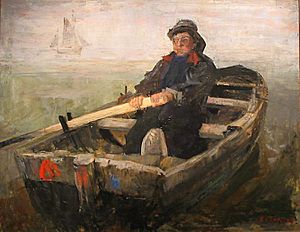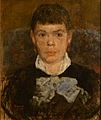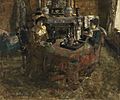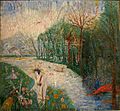James Ensor facts for kids
Quick facts for kids
James Ensor
|
|
|---|---|
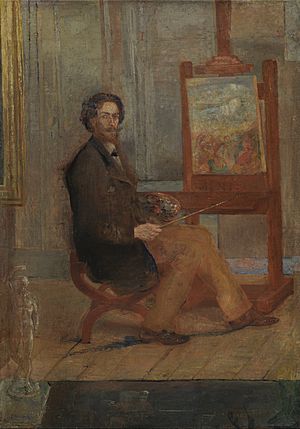
Self-Portrait of James Ensor by his Easel, 1890
|
|
| Born |
James Sidney Ensor
13 April 1860 |
| Died | 19 November 1949 (aged 89) |
| Nationality | Belgian |
| Education | Académie Royale des Beaux-Arts, Brussels (Belgium) |
| Known for | Painting, graphic arts |
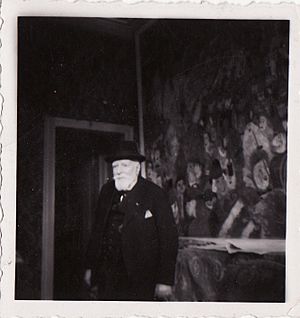
James Sidney Edouard, Baron Ensor (13 April 1860 – 19 November 1949) was a Belgian painter and printmaker, an important influence on expressionism and surrealism who lived in Ostend for most of his life. He was associated with the artistic group Les XX.
Biography
Ensor's father, James Frederic Ensor, born in Brussels to English parents, was a cultivated man who studied engineering in England and Germany. Ensor's mother, Maria Catherina Haegheman, was Belgian. Ensor himself lacked interest in academic study and left school at the age of fifteen to begin his artistic training with two local painters. From 1877 to 1880, he attended the Académie Royale des Beaux-Arts in Brussels, where one of his fellow students was Fernand Khnopff. Ensor first exhibited his work in 1881. From 1880 until 1917, he had his studio in the attic of his parents' house. His travels were very few: three brief trips to France and two to the Netherlands in the 1880s, and a four-day trip to London in 1892.
During the late 19th century, much of Ensor's work was rejected as scandalous. However, Ensor's paintings continued to be exhibited and he gradually won acceptance and acclaim. In 1895 his painting The Lamp Boy (1880) was acquired by the Royal Museums of Fine Arts of Belgium in Brussels, and he had his first solo exhibition in Brussels. By 1920 he was the subject of major exhibitions; in 1929 he was named a Baron by King Albert, and was the subject of the Belgian composer Flor Alpaerts's James Ensor Suite; and in 1933 he was awarded the band of the Légion d'honneur. Alfred H. Barr, Jr., the founding director of the Museum of Modern Art in New York, after considering Ensor's 1887 painting Tribulations of Saint Anthony (now in MoMA's collection), declared Ensor the boldest painter working at that time.
Even in the first decade of the 20th century, however, Ensor's production of new works was diminishing, and he increasingly concentrated on music—although he had no musical training, he was a gifted improviser on the harmonium, and spent much time performing for visitors. Against the advice of friends, he remained in Ostend during World War II despite the risk of bombardment. In his old age, he was an honored figure among Belgians, and his daily walk made him a familiar sight in Ostend. He died there following a short illness, on 19 November 1949 at the age of 89.
Art
While Ensor's early works, such as Russian Music (1881) and The Drunkards (1883), depict realistic scenes in a somber style, his palette subsequently brightened and he favored increasingly bizarre subject matter. Subjects such as carnivals, masks, puppetry, skeletons, and fantastic allegories are dominant in Ensor's mature work.
The four years between 1888 and 1892 mark a turning point in Ensor's work. He turned to religious themes. In 1888 alone, he produced forty-five etchings as well as his most ambitious painting, the immense Christ's Entry Into Brussels in 1889. Also known as Entry of Christ into Brussels, it is considered "a forerunner of twentieth-century Expressionism." The painting is now at the J. Paul Getty Museum in Los Angeles.
As Ensor achieved belated recognition in the final years of the 19th century, his style softened and he painted less in the 20th century. Ensor turned more and more to music in his later years, playing the harmonium and even composing a ballet-pantomime in one act, The Scale of Love (1907), complete with an original libretto, sets, and costumes. He is known to have stated in later years that he had followed the wrong path in life, feeling that he should have devoted himself to music.
Printmaking
Ensor was a prolific and accomplished printmaker. He created 133 etchings and drypoints over the course of his career, with 86 of them made between 1886 and 1891 during the height of Ensor's most creative period.
Honour
- 1919: Commander of the Order of Leopold.
Influence and legacy
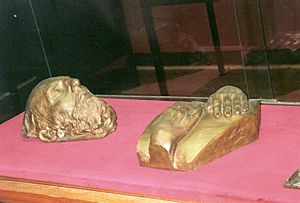
Ensor is considered to be an innovator in 19th-century art. Although he stood apart from other artists of his time, he significantly influenced many 20th-century expressionist and surrealist painters.
Ensor's works are in many public collections, notably the Modern Art Museum of the Royal Museums of Fine Arts of Belgium in Brussels, the Royal Museum of Fine Arts in Antwerp, and Mu.ZEE in Ostend. Major works by Ensor are also in the Museum of Modern Art in New York, the Musée d'Orsay, Paris, the J. Paul Getty Museum in Los Angeles, and the Wallraf-Richartz Museum in Cologne. A collection of his letters is held in the Contemporary Art Archives of the Royal Museums of Fine Arts in Brussels. The Ensor collections of the Flemish fine art museums can all be seen at the James Ensor Online Museum.
Images for kids
See also
 In Spanish: James Ensor para niños
In Spanish: James Ensor para niños



